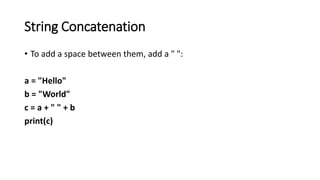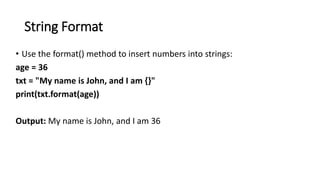The document provides a comprehensive overview of strings in Python, emphasizing their characteristics as immutable sequences of characters. It covers the creation, manipulation, and various operations on strings, including indexing, slicing, and formatting. Additionally, it details built-in string methods such as upper(), lower(), and replace(), enabling users to effectively handle text data.
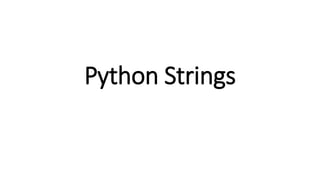
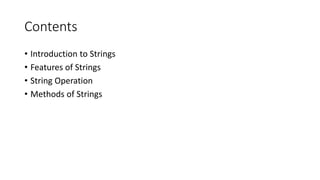
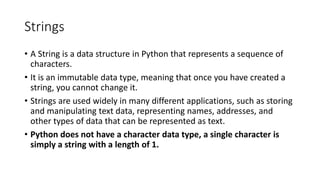
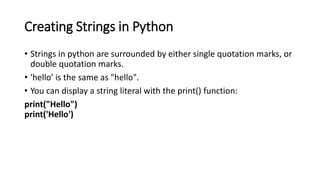
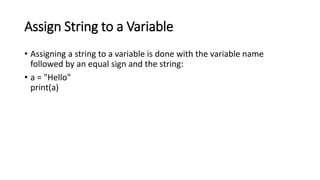
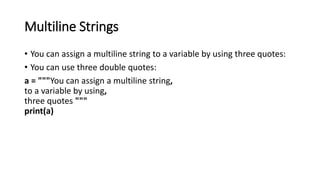
![Strings are Arrays
• Strings in Python are arrays of bytes representing Unicode characters.
• Python does not have a character data type, a single character is simply a
string with a length of 1.
• Square brackets can be used to access elements of the string.
• Get the character at position 1 (remember that the first character has the
position 0):
a = "Hello, World!"
print(a[1])
• OUTPUT: e](https://image.slidesharecdn.com/pythonstrings-240423220110-8d1c4c98/85/Python-Strings-and-its-Featues-Explained-in-Detail-pptx-7-320.jpg)
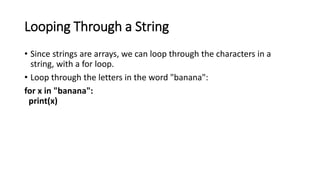
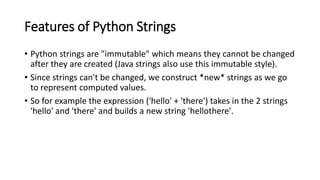
![Features of Python Strings
• Characters in a string can be accessed using the standard [ ] syntax.
• Python uses zero-based indexing, so if s is 'hello' s[1] is 'e'.
• If the index is out of bounds for the string, Python raises an error.
Accessing characters in Python String
• In Python, individual characters of a String can be accessed by using the
method of Indexing. Indexing allows negative address references to access
characters from the back of the String, e.g. -1 refers to the last character, -2
refers to the second last character, and so on.
• While accessing an index out of the range will cause an IndexError. Only
Integers are allowed to be passed as an index, float or other types that will
cause a TypeError.](https://image.slidesharecdn.com/pythonstrings-240423220110-8d1c4c98/85/Python-Strings-and-its-Featues-Explained-in-Detail-pptx-10-320.jpg)


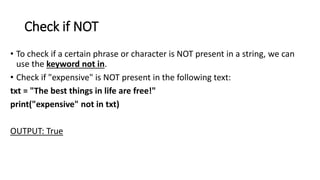

![Slicing Strings
Slicing
• You can return a range of characters by using the slice syntax.
• Specify the start index and the end index, separated by a colon, to return a
part of the string.
• Get the characters from position 2 to position 5 (not included):
b = "Hello, World!"
print(b[2:5])
Note: The first character has index 0.
OUTPUT: llo](https://image.slidesharecdn.com/pythonstrings-240423220110-8d1c4c98/85/Python-Strings-and-its-Featues-Explained-in-Detail-pptx-15-320.jpg)
![Slice From the Start
• By leaving out the start index, the range will start at the first
character:
• Get the characters from the start to position 5 (not included):
b = "Hello, World!"
print(b[:5])](https://image.slidesharecdn.com/pythonstrings-240423220110-8d1c4c98/85/Python-Strings-and-its-Featues-Explained-in-Detail-pptx-16-320.jpg)
![Slice To the End
• By leaving out the end index, the range will go to the end:
• Get the characters from position 2, and all the way to the end:
b = "Hello, World!"
print(b[2:])](https://image.slidesharecdn.com/pythonstrings-240423220110-8d1c4c98/85/Python-Strings-and-its-Featues-Explained-in-Detail-pptx-17-320.jpg)
![Negative Indexing
• Use negative indexes to start the slice from the end of the string:
Get the characters:
• From: "o" in "World!" (position -5)
• To, but not included: "d" in "World!" (position -2):
b = "Hello, World!"
print(b[-5:-2])
OUTPUT: orl](https://image.slidesharecdn.com/pythonstrings-240423220110-8d1c4c98/85/Python-Strings-and-its-Featues-Explained-in-Detail-pptx-18-320.jpg)
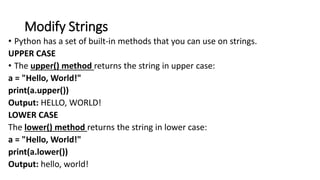


![Split String
• The split() method returns a list where the text between the specified
separator becomes the list items.
• The split() method splits the string into substrings if it finds instances of
the separator:
a ="Hello, World!"
print(a.split(","))
OUTPUT: ['Hello', ' World!']](https://image.slidesharecdn.com/pythonstrings-240423220110-8d1c4c98/85/Python-Strings-and-its-Featues-Explained-in-Detail-pptx-22-320.jpg)

